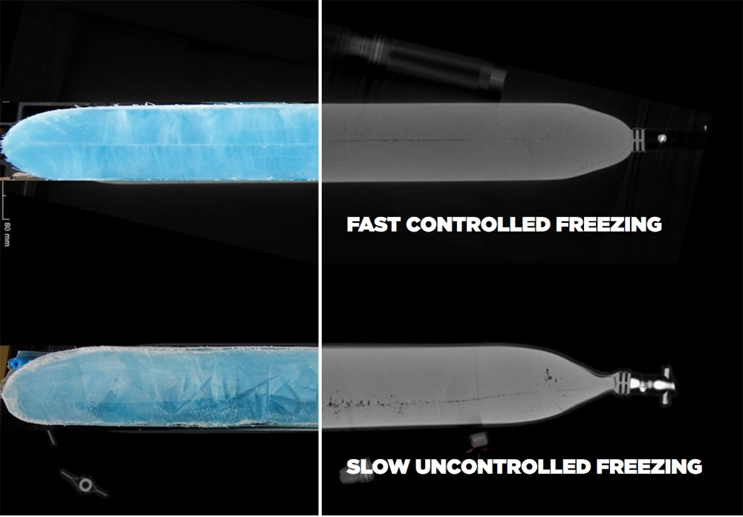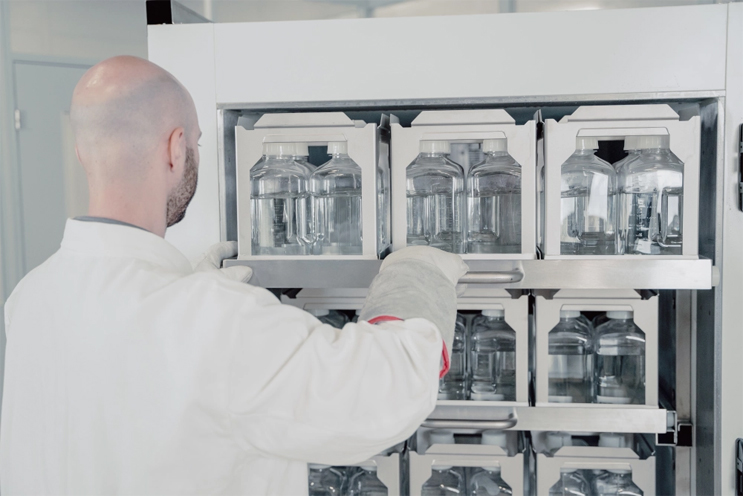A Guide To Pharmaceutical Cold Chain Management
By Alexander Fuchs

With the emergence of many innovative approaches in the biopharmaceutical industry in recent years, life sciences companies have needed to put increasing efforts into pharmaceutical cold chain management. Many newly developed, highly sensitive biopharmaceuticals involved in groundbreaking, life-saving therapies have individual requirements that must take into consideration their safe handling, including storage and transportation.
All relevant stakeholders – from pharma manufacturers to service providers to healthcare providers – must pay attention to these requirements. Here, you will discover why temperature plays an essential role in the entire supply chain of cutting-edge cold chain products. We also provide an overview of the most frequently used temperature ranges in freezing drug substances and the long term storage of modern therapeutics.
Pharmaceutical cold chain logistics are a major challenge in the supply chain
The complexity of pharmaceutical supply chains has increased immensely over recent decades, and with temperature-sensitive products leaving pharmaceutical companies to be shipped worldwide, distributors depend on reliable solutions for cold chain logistics – from packaging solutions to highly advanced refrigeration devices.
Regulators such as the Food and Drug Administration (FDA) and the European Medicines Agency (EMA) have reacted to the increased complexity that comes with the supply chain of biologics, for example by implementing Good Distribution Practice (GDP) as a regulatory framework for distributors of medicines, to ensure their viability and safety.
Whitepaper: How Controlled & Scalable Freezing Becomes Reality
Main temperature ranges to be considered along supply chains
Apart from the ultra-cold environment predominant in a fridge for lab for example (usually -40°C to -80°C ), there are two other important temperature ranges that are used to frame storage conditions for temperature-sensitive pharmaceuticals under temperature-control, as outlined below.
Ambient temperature
Controlled room-temperature refers to a temperature range between 20°C and 25°C. This, though, does not at all mean that products stored under these temperatures are indifferent to temperature excursions and that temperature control is not necessary.
Refrigerator temperature
A chilled environment, for example in a refrigerator, is characterized by temperatures between 2°C and 8°C and is appropriate for products that must be kept cool but prevented from being completely frozen.
Cryogenic temperature
Products to be stored at cryogenic temperatures require an environment with low to ultra-low sub-zero temperatures. In the process of cryogenic freezing, for example, temperatures can be lower than -150°C, which requires dedicated cooling and storage solutions that go far beyond the capabilities of a household freezer.
As for the importance of the pharma cold chain in the distribution of many medicines and biosimilars, the numbers speak for themselves: In 2015, more than half of the temperature-sensitive products shipped were stored at room temperature, while 31% were refrigerated and 17% were frozen. Additionally, the use of mRNA vaccines as a means to fight the COVID-19 pandemic has further underlined the need for professional cold chain solutions.1
Our Cryogenic Freezer RoSS.LN2F
Individual temperature requirements of different products
Considering the required temperatures for the storage and transport of various biological products, selecting the exact temperature to be used is in no way an arbitrary choice, but depends on a product’s characteristics. Although the ideal storage temperature may vary within product groups, certain temperature ranges can be clearly given for each of them.
- Monoclonal antibodies and mRNA: stored at -80°C
- Gene therapies: stored at -80°C
- Cell therapies: stored at -130°C and below
- Gene-modified cell therapies: stored at temperatures lower than -150°C
Monoclonal antibodies and mRNA: stored at -80°C
Particularly with the development of COVID-19 vaccines, public awareness of mRNA has grown immensely, along with knowledge of its need for dedicated storage solutions. As it is vital to prevent RNA from degrading, and because some of its components have been shown to still be active at temperatures down to -70°C, a storage environment with temperatures between -20°C and -80°C is considered ideal.
Antibodies have similar requirements for their storage temperature, although the specifics may vary depending on the type of antibody. Generally, however, monoclonal antibodies are stored under liquid nitrogen with temperatures between -20°C and -80°C. In addition to requiring storage at a specific set of temperatures, monoclonal antibodies – immunoglobulins that are made by cloning white blood cells – require fast freezing techniques to prevent cryoconcentration, denaturation, and the formation of aggregates. This is usually achieved using a technique known as plate freezing.

Gene therapies: stored at -80°C
Gene therapies are aimed at either modifying or substituting existing DNA in a cell to fulfill a therapeutic function or to substitute damaged or harmful segments of DNA; this offers new possibilities in the attempt to cure genetic diseases. Vectors are an important tool in the application of gene therapies and are vehicles that are designed to insert DNA into a cell’s nucleus, where the DNA is then read and further processed.
To provide maximum product viability and safety for components used in gene therapy – adeno-associated viruses (AAVs), for instance – storage under ultra-low temperatures is necessary, usually at around -80°C.
Cell therapies: stored at -130°C and below
Cell therapies have enabled huge advances in the fight against a variety of diseases that were previously considered difficult to cure. Cell therapy uses the injection of viable cells – such as stem cells or B cells – harvested either from the patient themself (i.e. autologous cell therapy) or from a donor (i.e. allogeneic cell therapy).
As its name suggests, cell therapy relies on viable cells. These cell therapies are usually derived from a manufacturing process that often involves a long period of time between the harvesting of cells and the actual application of the product. Therefore, appropriate storage is essential and much will depend on how long the product must be stored before it is to be applied. The long-term storage of cell products, for instance, requires cryopreservation at temperatures lower than -130°C if the cell structure is to remain intact.2
Gene-modified cell therapies: stored at temperatures lower than -150°C
Another application for ultra-cold freezing and storage is gene-modified cell therapy. This therapeutic approach involves cells being harvested and genetically modified in vitro prior to their administration to a patient for the treatment of a variety of diseases, including various types of cancer.
There are several types of gene modification used to create cells for therapeutic purposes. For instance, gene modification is indispensable for chimeric antigen receptor T-cell therapy (CAR T-cell therapy) and the production of T-cell receptor therapies (TCR therapies).
Given that gene-modified cell therapies are based on genetic modification performed outside of a patient’s body, the corresponding cells must be kept stable in an ex vivo environment for a certain period. Cryopreservation techniques are frequently used for the long-term storage of these cells at temperatures that are usually lower than -150°C.
Secure cold chain management with Single Use Support
No matter what the specific needs of biologics are in terms of storage conditions, it is vital to guarantee process safety and product quality along the entire supply chain, and to minimize biopharma supply chain risks as best as possible. Therefore, the biopharma industry relies on dedicated freezing and storage solutions. This is where Single Use Support comes into action, with a product portfolio including RoSS.pFTU as a scalable freeze/thaw platform, as well as RoSS.FRDG – an ultra-low temperature freezer that achieves a high level of temperature stability for long-term storage.

In terms of packaging, Single Use Support can yet again be of help, providing secure single-use packaging solutions, such as IRIS single-use bags, as well as RoSS shells, designed to protect your single-use bioprocess containers.
Cold chain shipping – meeting requirements
To meet the requirements of cold chain shipping of biologics, great focus must be put on the appropriate cold chain equipment, e.g. on dedicated transport boxes: Single Use Support has therefore developed RoSS.SHIP – a smart shipping container that can keep temperatures below -60 °C for at least six days.
Video: Freeze & Thaw Platform Overview
References
- Time- and Temperature-Controlled Transport: Supply Chain Challenges and Solutions., Published 2018 Mar
- Cryopreservation as a Key Element in the Successful Delivery of Cell-Based Therapies—A Review, http://dx.doi.org/10.3389/fmed.2020.592242, Published 2020-11-26
About The Author
Alexander is Head of Product Line Management. He owns a wide range of experience and knowledge in various and different industries such as jewellery, manufacturing industry and biopharma, and multiple areas of activities due to his highly technical education and intensive insights.
Passionate for Automation, Engineering and Process Management Alexander contributes to the innovative focus of advancing cold chain management within the biopharmaceutical industry.
